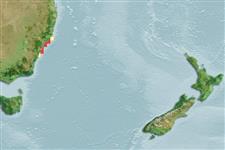>
Acropomatiformes (Oceanic basses) >
Creediidae (Sandburrowers)
Etymology: Creedia: Greek, kreesi, kreas = somebody that receives or keeps flesh (Ref. 45335).
Eponymy: John Mildred Creed (1842–1930), a friend of Ogilby’s, was an English-born Australian physician and politician. [...] (Ref. 128868), visit book page.
Environment: milieu / climate zone / depth range / distribution range
Ecologia
marino associati a barriera corallina; distribuzione batimetrica 10 - 15 m (Ref. 9002). Subtropical
Southwest Pacific: Sydney, Australia.
Size / Peso / Age
Maturity: Lm ? range ? - ? cm
Max length : 7.0 cm TL maschio/sesso non determinato; (Ref. 9002)
Short description
Chiavi di identificazione | Morfologia | Morfometria
Spine dorsali (totale) : 0; Raggi dorsali molli (totale) : 14 - 16; Spine anali: 0; Raggi anali molli: 25 - 28; Vertebre: 45 - 47. Sandy colored dorsally, translucent ventrally; fins transparent (Ref. 9002).
Occurs in clean sand areas in the vicinity of rocky reefs (Ref. 9002). Buries deep in sand (Ref. 9002).
Life cycle and mating behavior
Maturità | Riproduzione | Deposizione | Uova | Fecundity | Larve
Kuiter, R.H., 1993. Coastal fishes of south-eastern Australia. University of Hawaii Press. Honolulu, Hawaii. 437 p. (Ref. 9002)
IUCN Red List Status (Ref. 130435: Version 2024-2)
Threat to humans
Harmless
Human uses
Strumenti
Special reports
Download XML
Fonti Internet
Estimates based on models
Preferred temperature (Ref.
123201): 20.8 - 22.1, mean 21.3 °C (based on 4 cells).
Phylogenetic diversity index (Ref.
82804): PD
50 = 0.5625 [Uniqueness, from 0.5 = low to 2.0 = high].
Bayesian length-weight: a=0.00102 (0.00046 - 0.00225), b=3.06 (2.88 - 3.24), in cm total length, based on all LWR estimates for this body shape (Ref.
93245).
Trophic level (Ref.
69278): 3.3 ±0.4 se; based on size and trophs of closest relatives
Fishing Vulnerability (Ref.
59153): Low vulnerability (10 of 100).
